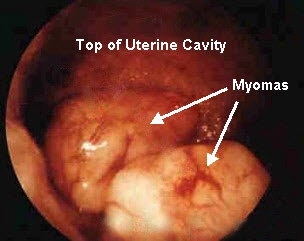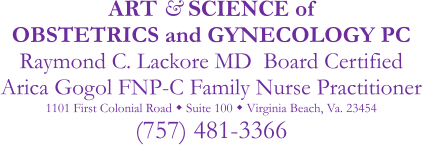Minimally Invasive Hysteroscopy
Hysteroscopy refers to the use of a thin tubular scope that is inserted through the cervix into the uterine cavity. The Hysteroscope is small enough that it can fit through the cervix with minimal or no dilation. The inside of the uterus is a collapsed cavity, to see inside it is necessary to fill (distend) it with either sterile liquid in order to see. Diagnostic hysteroscopy and simple operative hysteroscopy can usually be done in an office setting. We are proud to offer hysteroscopy in our office under the care of Board-certified Anesthesiologists.
 View through a hysteroscope: This is a view through a hysteroscope during office hysteroscopy. It shows the inside of the inside of a uterus with two myomas (fibroids) on the back wall. The top of the uterus is seen and appears normal. Myomas (Fibroids) like this can cause severe cramping (dysmenorrhea), heavy menstrual flow (menorrhagia) and bleeding between periods (metrorrhagia.) This may be diagnosed by hysteroscopy.
View through a hysteroscope: This is a view through a hysteroscope during office hysteroscopy. It shows the inside of the inside of a uterus with two myomas (fibroids) on the back wall. The top of the uterus is seen and appears normal. Myomas (Fibroids) like this can cause severe cramping (dysmenorrhea), heavy menstrual flow (menorrhagia) and bleeding between periods (metrorrhagia.) This may be diagnosed by hysteroscopy.
These types of tumors can be removed using a special kind of hysteroscope called a resectoscope.
This photograph also taken during office hysteroscopy shows a polyp in the lower part of the uterus. This type of polyp often causes bleeding between periods and is easily removed in the office. Again, office hysteroscopy allowed quick and accurate diagnosis of the cause of abnormal bleeding. The polyp was removed by simple operative hysteroscopy during the same visit.
How is Diagnostic Hysteroscopy done?
I do nearly all hysteroscopy in my office under General Anesthesia. I numb the cervix (this is easily done and rarely uncomfortable.) I attach a video camera to the hysteroscope and then insert the hysteroscope into the uterus under direct vision while using sterile either saline to fill the uterus. I then can look for fibroids, polyps, and other problems that may be causing bleeding. This often takes about 5 minutes. Photographs may be taken and a Dilation and Curettage is commonly done. Most women are able to get up and return to their normal activities within 12- 24 hours.uncomfortable.
What is Operative Hysteroscopy?
During operative hysteroscopy a type of hysteroscope is used that has channels in which it is possible to insert very thin instruments. These instruments can be used to remove polyps, to cut adhesions, and do other procedures. With the development of better and smaller instruments, I find that I am able to remove some polyps in addition to doing other procedures that used to require a full operating room. In many situations, operative hysteroscopy may offer an alternative to hysterectomy.

